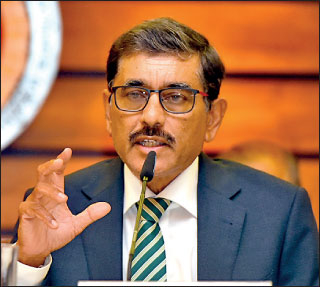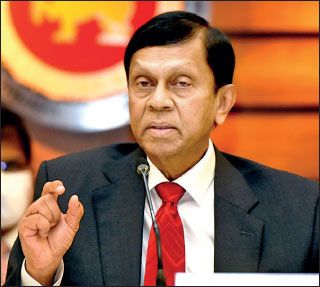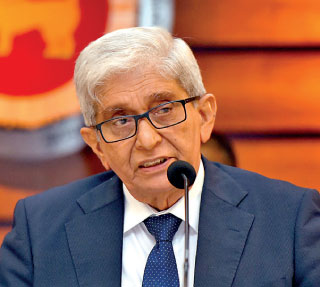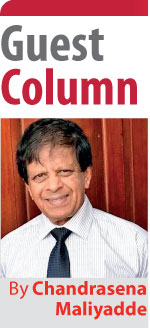Thursday Dec 25, 2025
Thursday Dec 25, 2025
Wednesday, 20 July 2022 00:31 - - {{hitsCtrl.values.hits}}

Central Bank Governor Dr. Nandalal Weerasinghe

Former Central Bank Governor Ajith Nivard Cabraal

Former Central Bank Governor Prof. W.D. Lakshman
 An expert panel discussion on ‘Surviving the Current Economic Crisis: Ex-Central Bankers in Dialogue’ was held in early June. Some speakers stressed that the need of the hour is an independent Central Bank (CBSL). But its relevance or impact on surviving the current economic crisis was not spelt out. May be we ignorant laymen could not understand. Perhaps independence may be for the survival of the Central Bank and its officers who spend time in cold rooms away from the crisis.
An expert panel discussion on ‘Surviving the Current Economic Crisis: Ex-Central Bankers in Dialogue’ was held in early June. Some speakers stressed that the need of the hour is an independent Central Bank (CBSL). But its relevance or impact on surviving the current economic crisis was not spelt out. May be we ignorant laymen could not understand. Perhaps independence may be for the survival of the Central Bank and its officers who spend time in cold rooms away from the crisis.
The Central Bank of Ceylon was established by the Monetary Law Act (MLA) No. 58 of 1949. Sitting and Ex Central Bankers eloquently speak of its intended role. But, we laymen are cognitively deficient to understand any tangible role played by it other than that it was renamed as the Central Bank of Sri Lanka (CBSL) in 1985. It is a matter for learned ex central bankers.
Professor Sirimevan Colombage, in spite of being an ex-central banker has stated in his article on Monetary Board collectively accountable for imprudent policy decisions (https://www.ft.lk/columns/Monetary-Board-collectively-accountable-for-imprudent-policy-decisions/4-735512) that “It is widely recognised that in a democratic system, central bank independence must always be accompanied by adequate mechanisms of accountability”. I invite those who shout for the independence of the CBSL to read Colombage’s article.
Since its establishment, CBSL has had 16 Governors. The Monetary law Act was passed 73 years back. Gota Go Gama youths found fault with all of us who were connected to the downfall of Sri Lanka during the last 73+1 years. No way can the CBSL absolve itself by citing the Act “our job is managing Monetary Policy to ensure the stability”. Some boast how cleverly and vigorously they conducted tough negotiations to beg and borrow an additional Dollar to augment the Foreign Exchange Reserves.
During the post-1978 period we all including CBSL have, collectively, driven a flourishing producing economy down a steep road towards a begging debt-driven trading economy. All 15 Governors have talked of debt restructuring and debt sustainability. For the first time a non-Central Banker Governor Prof. W.D. Lakshman talked of a debt-free country and has paid the price in resignation and facing court cases.
A seasoned Central Banker is at the helm of CBSL today. He was taken on a red carpet attired in normal trappings such as experience, who is familiar with Central Bank traditions, who understands the mandate (stability at any cost), readiness for tough negotiations with IMF, independent monetary policy, financial market leader, etc. etc. His first job was to declare the bankruptcy of the economy using different terms such as hard default and soft default. Then went for tough negotiations with IMF without doing homework and was speechless when IMF requested for the program of recovery. He arrested the Rupee within a narrow range at a time when the rupee value of a Dollar was high.
Prof. Lakshman was holding the exchange rate stable when the Rupee value of the Dollar was lower. He came under severe criticism. Some argued that the stable exchange rate resulted in diverting Dollar earnings from official sources to the black market. His successor let the Rupee float and brought near 400 to a Dollar. Black market did not disappear. Dollars did not come through the official sources.
Kapila Bandara in his article on “Exporters, importers shift Rs. 13.2 trillion overseas via dodgy invoicing” (https://www.sundaytimes.lk/220710/news/exporters-importers-shift-rs-13-2-trillion-overseas-via-dodgy-invoicing-488561.html) reveals that importers and exporters intentionally falsify the declared value of goods on invoices filed with Sri Lanka Customs. Quoting Washington, DC-based Global Financial Integrity’s 2021 report he states that Sri Lanka’s businesses involved in the exports and imports trade have plundered $ 36.833 billion (Rs. 13.246 trillion) over nine years (2009-2018) through intentional, dodgy invoicing, and stashing the foreign exchange earnings offshore.
Economists argued that it is normal and let the Rupee float to attract such foreign exchange retained off shore. But Lakshman who knows economics as well as the ground situation and the behaviour of importers and exporters held the rupee stalled. He issued a circular requesting the importers and exporters to remit the foreign exchange earnings held abroad. His successor gave in and let the Rupee float and contributed to a spiralling inflation. Black market did not disappear as anticipated. Nor did the foreign reserves build up. Current CBSL Governor, realising the stark truth, banned open account trading.
Some argue that Lakshman printed excessive money to bridge the budgetary gap. We laymen know that the economy and normal life were shattered by the COVID-19 pandemic. Respective governments world over put more money into the market to help both producers especially small and medium scale and consumers. Being the apex financial institution of the country, the Central Bank provided its full scope of essential services to the economy and the financial system during the lockdown. The Central Bank actively took steps to ease the burden on the general public during this unprecedented disruption of global scale, while preserving the focus on its legal mandate to maintain economic, price and financial system stability.
Economists forecasted that the economy would recover taking shapes of all 26 letters in the English alphabet. And they thought that it would automatically happen. Even the deities of the market economic system such as the US, Europe and South-east Asian countries pumped money into the market with increased Government intervention. Our neo liberal economists have been up in arms for navigating the market economy derailed by the pandemic.
There is justification of deficit/compensatory financing to fill the budget gap. This is what Keynes proposed in 1936 as the solution to the problem of economic downturn. The worst such seen so far was the Great Depression of the 1930s. COVID-19 hit the entire world and was several times worse than the Great Depression. The Sri Lankan economy was no exception.
Every successive government since independence gradually widened the welfare net covering more and more people. The population has developed the conviction over the years that the state welfare benefits which they had enjoyed for some time were part of their inalienable social rights. Even we, the learner beneficiaries of “Free Education” believe in continuation of free education with higher budgetary allocations. In this background what was the option available for Sri Lanka other than printing money?
It is true increased money supply would lead to increased demand resulting in price increase. This is called demand pull inflation in economic parlors. In Sri Lanka demand is inelastic. Nearly 50% of the population is below or hovering around the poverty line. They don’t care for the price as they have to buy the essentials, mostly the food items, for their mere survival. When it comes to the richest cohort they buy mostly luxuries. For them the convenience, comfort and the status symbol is more important than the price. They buy such luxuries at any price. Their demand is also price inelastic. In such a distorted market, increased money printing does not have the impact on inflation to the extent exaggerated by most economists. This would have been the reason for the current CBSL Governor to agree to print Rs. 1 trillion to enable the Finance Minister to pay the Public sector salaries.
Further, the money supply is composed of different modes more than what is stated in the Monetary Law Act. Market is flooded with more invisible modes of money than visible types. Currency issued by CBSL has taken a back seat. By controlling printing of money alone would not discourage the demand in the presence of many other modes available in the financial market.
Many writers and economists attribute to policy errors as causes for the current economic crisis. I do not disagree that there were policy errors. But the entire crisis cannot be explained by policy errors made by recent CBSL Governors alone. It has happened over a considerable period. It is time for all of us including the Central Bank to come out of shells and get exposed to reality. Reality is not found in the economics texts. Not found in The Monetary Law Act. Not found in cold rooms or towers. It is found outside of these. There are many changes undergoing outside CBSL. World is facing changes. Problems are taking different shapes demanding different solutions.
Many generations were born after the Monetary Law Act was passed 70 years ago. Habits, patterns, tastes, processes have changed. Governance has changed. Capitalism is undergoing changes. Socialism is near extinct. There are many inventions and innovations. Our younger generations are much more vigilant, educated and equipped with many talents. It is no longer possible to sit on an obsolete Act and talk of independence in a world with different actors.
This is why the new CBSL Governor who was brought on red carpet wrapped with decorative cosmetic outfits is dropping them one after the other to get adjusted to the fast changing world. When the world around us is undergoing fast dramatic changes CBSL alone cannot stand still.
(The writer was a Ministry Secretary. He is currently a Vice President of the Sri Lanka Economic Association. He can be reached via [email protected].)